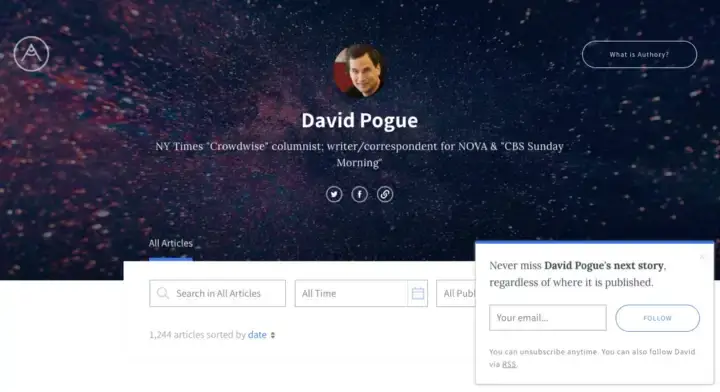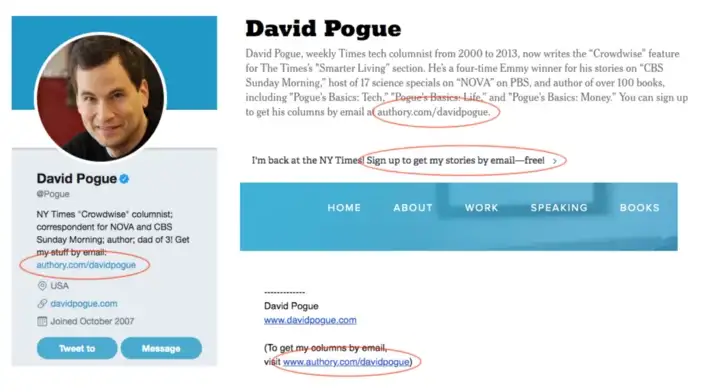Hi David, great to have you. Please tell us a little bit about your background as a journalist.
I’m probably best known as a tech writer since I spent 13 years writing for computer magazines. And then another 13 years writing the weekly tech column for the New York Times. And then five years writing about tech for Yahoo Finance. And writing 120 computer how-to books (if you count all the updated editions).
Name: David Pogue
Authory page: authory.com/DavidPogue
Number of articles: 1,244
Number of publications: 4
Today, I’m back at The Times, but the new column has nothing to do with tech. It’s called “Crowdwise,” and it crowdsources (from the readership) solutions to life’s unsolvable problems, like how to fly with babies, what to say to someone in mourning, and how to recover from a bad “Reply All.”
I’m also writing occasional tech how-to stories for The Times. And tech reviews for New York Magazine’s “Strategist” site.
And, of course, I’m doing a ton of stories for “CBS Sunday Morning,” where I’ve been reporting on science, tech, theater, and other topics since 2002.
I’m still writing those computer books, too (in the “Missing Manual” series that I created in 1999).
You have been using Authory for more than a year now. What did you look for initially?
Yahoo was a great place to work — great people, great freedom, super generous. But there was one huge problem: In my then-coworker Katie Couric’s words, we felt like we were in the witness protection program. We were doing great work, but you couldn’t FIND IT!
You couldn’t search for our stories. You couldn’t subscribe to them. You couldn’t get notifications. There was no newsletter.
It was supremely frustrating.
You can’t imagine how teeth-gritty it gets when the thousandth person on the street or in an airport says, “Where can I read your stuff?” (What am I supposed to say? “Oh, just go to https://www.yahoo.com/author/david-pogue?”)
Eventually, I found a service that turns RSS feeds into email notifications, and I told people they could sign up for THAT. (Yes, I literally instructed people on how to paste in an RSS address to sign up for my articles. How’s THAT for a good user experience?)
Anyway, it worked OK until Yahoo changed its RSS address structure and broke all of those thousands of signups.
Readers and fans could have a clean, simple, ad-free, one-click, reliable way of getting notified when I posted a story.
So for me, the huge appeal of Authory was that, FINALLY, readers and fans could have a clean, simple, ad-free, one-click, reliable way of getting notified when I posted a story. It immediately became apparent that Authory was an infinitely better solution than the jerry-rigged systems I’d been using.

Get started for free now.
And how has Authory worked for? Have your expectations been fulfilled?
For me, the second most important Authory feature was that my “followers” are MINE. If I ever moved from one publication to another, they would all continue to get my stuff! Automatically, without having to sign up for anything again!
If such a thing had existed when I left the NY Times in 2013, I wouldn’t have dropped off the face of the earth. Fans and followers would have just kept right on getting my columns and videos, and I would not have had to start all over again, abandoning all the goodwill and name recognition I’d spent 13 years building at The Times.
At least that was the theory. I finally put it to the test in 2018 when I left Yahoo and went BACK to The Times — and to New York Magazine. BOOM: All of my Authory followers kept right on getting my stuff. My readers didn’t bat an eye. There was no starting over; I hit the ground running.
(The fact that I own the list of my followers’ email addresses is greatly reassuring. I have never yet sent out an email blast to this list — to promote a project, for example — because I feel as though reader trust is so easily broken. If anyone feels as though I’m spamming them, then that’s an ex-fan. But I have a book coming out next year, and I’ve been considering sending out ONE notification to this list of known Pogue fans about it.)
How do you gain email subscribers with Authory?
I include my Authory address (authory.com/davidpogue) everywhere fine bios are posted: In my email signature, in my profiles (for Facebook, Twitter, LinkedIn, Instagram), in my NY Times bio, in my books, and at the top of my website (davidpogue.com).
It occurred to me last week that I had never actually tweeted my Authory link! So I mentioned my Authory address on Twitter, and in the next 18 hours, 230 more people signed up to follow my stuff! I guess I should do that every now and then.

What about Twitter and Facebook — couldn’t they do the job?
You mean, why don’t I post my stories on Twitter and Facebook?
I do, but that’s a scattershot way of promoting stories. First of all, not everyone is ON Facebook or Twitter. Second, even people who ARE on those services see only an algorithmically determined subset of posts, as we know. If a fan doesn’t happen to be on Twitter when my tweet scrolls through the stream, or if Facebook chooses not to make my post appear, people won’t see it.
Twitter and Facebook are a scattershot way of promoting stories. Email is a much, much more universal system.
Email is a much, much more universal system. Everyone gets every email — no algorithms choosing messages — and they’ll see the messages whenever they check.
I know that you’ve always had a personal and direct relationship with your readers. What’s the feedback from your readers like since you started using Authory?
Well, there’s very little feedback from readers. And that is incredibly high praise.
It means that I’m offering them a service that they want, that works as they expect. Nobody complains, needs further instruction, or has trouble — and that’s exactly what I’d hope for.
I don’t see much written about the aesthetics of Authory, either — the clean, white, calm, typographically elegant webpage of my stories, and the clean, white, calm, typographically elegant email notifications. No ads, no clutter, no blinking or animations. It doesn’t smell of commercialism or scamminess, which is a huge plus. I strongly believe that readers immediately trust the thing, and that’s why so many of them are willing to provide their email addresses and click Follow.
What would you say to your journalist colleagues about Authory?
Most journalists today write for lots of publications and move around a lot. Think of how much time and effort you’ve spent building your audience at Publication A — and what a waste it is to ABANDON them when you move to Publication B!
As the media world collapses, splinters, and shifts around us, Authory makes it possible for YOU to be the brand, not your current publication. Readers can be YOUR audience, not your employers’. Why not start building a single, consolidated audience of fans that grows over the years of your career, no matter who you’ll be writing for?
To me, that’s the Authory pitch net in a nutshell.
As the media world collapses, splinters, and shifts around us, Authory makes it possible for YOU to be the brand, not your current publication. Readers can be YOUR audience, not your employers’
Thanks, David!
David and thousands of other journalists are using Authory to take control of their content and their audience. Join David for free at authory.com



